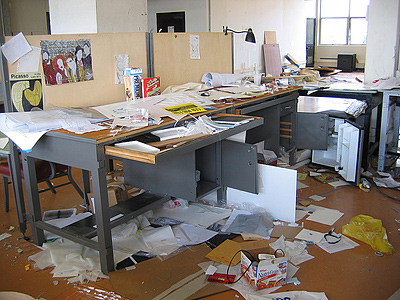Berkeleyan
 |
An unlikely sustainability scenario: Materials “left behind” by Wurster Hall students will be sorted and stored for re-use by next semester’s cohort. |
Sustainability Summit: A coming of age?
Students, staff, and faculty pitched in, prodded, and preached the green gospel
![]()
| 23 April 2008
“We need to think big; we need to scale this up,” Omar Khan said at Berkeley’s fifth annual Sustainability Summit, held Monday, April 21, the day before Earth Day. The Ph.D. student was describing the work of 15 students, through a climate-action course, to survey energy use in campus buildings and help address low-hanging fruit — like energy-hogging air-conditioning glitches and laboratory fume-hood sashes. (When a sash is left open, he noted, its exhaust fan consumes as much energy as three average houses — and there are 1,300 fume hoods across campus).
| Going for the green Monday’s Sustainability Summit was highlighted by two much-anticipated announcements: this year’s winners of eight campus Green Fund Grants, supporting innovative sustainability projects, and the winners of the campus’s annual Sustainability Awards. Green Fund Grant recipients for 2008, and their proposed projects, include Pat Goff (EH&S electric delivery vehicle); Trey Cauley and Professor of Mechanical Engineering Al Pisano (waterless urinals in Etcheverry Hall); Jeremy White (University Hall sun mirrors); Kameron Kitajima and the Green Campus Team (re-funding the Green Campus Program); Rebecca Anderson (task lighting in University Hall); Gary Imazumi (weather station to regulate irrigation); Theron Klos (mulch training for groundskeepers); and Merrian Fuller (workshop for architect/design students). Sustainability Awards were presented to the following individuals and entities: • Student Laura Moreno, a founding member of the Green Room Committee and the Building Sustainability at Cal program who has served as sustainability coordinator of Stanley Hall, Chancellor’s Advisory Committee on Sustainability (CACS) intern, and CACS co-chair. • Ashok Gadgil, an adjunct faculty member with the campus’s Energy and Resources Group and a senior research scientist at Lawrence Berkeley National Laboratory. Gadgil works on sustainability-related projects in developing nations. • Staff member Tim Pine, an environmental specialist with the Office of Environment, Health, and Safety (EH&S). He was instrumental in bringing biodiesel to campus garbage trucks, initiated a pilot program for bicycle use by EH&S staffers, and served as lead organizer for the first campus Alternative Transportation Fair. He has also dedicated significant time and expertise to restoring natural areas on campus by working with student-volunteer groups. • The Grant Making Committee of the Green Initiative Fund (TGIF) for its work administering grants from the $175,000 in annual funds generated by a new $5 student-fee referendum. |
The growing maturing of environmentalism at Berkeley was evident at the April 21 summit, as participants reported on concrete and varied programs — the lion’s share of them student-initiated — to conserve resources, mitigate the campus’s carbon footprint, and reduce waste. Summit participants, about 400 in total, also took stock of progress toward permanently incorporating sustainability concerns into the campus’s planning and operations — and identified unfinished work ahead.
In a morning session in Pauley Ballroom, graduate student Sam Borgeson described a project in Wurster Hall funded in part by a 2007 campus Green Grant. There, he said, a mountain of design-studio materials abandoned at semester’s end was a call to action for the sustainability-minded. Students swept through the wreckage to sort and store wood, glues, paints, and other materials — for reclamation the following semester by any student who might want them. Simple though labor-intensive, the program has diverted two to three tons of materials from the waste stream, he estimated, and offset as much as $10,000 of new purchases — while simultaneously “raising awareness of people who are going to go on to make much bigger decisions in the design and construction industry.”
Judy Chess, a project manager in Capital Projects, reported meanwhile on the progress being made toward incorporating sustainability criteria into campus remodeling, construction, and demolition projects. For the razing of Warren Hall, now in progress, a sorting machine is being used to separate out, for recycling, about 90 percent of the building’s concrete and steel. Similarly, a large percentage of the concrete from old Stanley Hall was salvaged, rather than discarded, when that building was demolished, she reported.
Two undergraduates gave an account of their efforts to find new homes for — rather than send to landfill — “unfathomable amounts of stuff” left in the eight-story Department of Health Services Building, in downtown Berkeley, when the campus acquired it as future site for the School of Public Health. Sophomores Lisa Veliz and Lindsey Sanders — participants in a pair of “Building Sustainability at Cal” participation-action courses — told of students’ water, waste, and energy audits of nine campus buildings. The ultimate goal for class participants, they said, is to so improve both the systems and occupant habits of the targeted facilities that these buildings will eventually qualify for certification under the U.S. Green Building Council’s LEED certification program.
A testament to the intensity of student interest in environmental responsibility, the summit was entirely organized and executed by students — from the programmatic details and food catering all the way to the handmade suggestion boxes, fashioned (naturally) from recycled materials.

